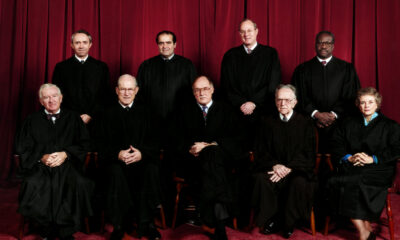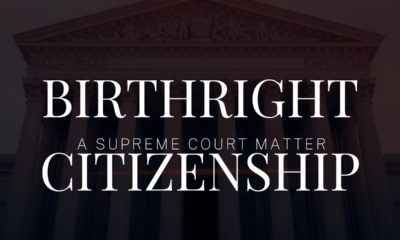Executive
Supreme Court Friday dump
On Friday, June 21, 2024, the United States Supreme Court released opinions on five cases. Only one of these cases had any breathless commentary in advance. But all five allowed the Originalists and the Moderates to clarify their positions on immigration and basic civil liberties. The Court has five or six Big Cases still on its docket and will release those, starting in two days. Indeed they have already added two more Non-Argument Days to their calendar. But the cases they “dumped” to the news media last Friday will tell us how Originalists and Moderates think.
Supreme Court upholds a federal enhancement to State domestic-violence protection orders
The case of United States v. Rahimi was one of five Big Cases CNAV noted that was still on the docket early Friday morning. John R. Lott, Jr. gave his opinion last fall that he didn’t think the United States government had any business denying a person the right to carry a firearm, just because some State had slapped a domestic-violence protection order on him. The problem, for Lott, is that domestic violence protection orders are civil matters, not criminal. As such, an applicant for such an order need only establish the usual elements for a preliminary injunction:
- Likelihood of proving, on the merits, that the respondent is a positive menace to the applicant,
- Very likely irreparable harm if the respondent is allowed to have a firearm,
- Comparatively little harm to the respondent if he loses his right to carry, and
- A public-interest imperative.
Even the final verdict in most domestic-violence cases (which are nasty divorces) requires proof by a preponderance of the evidence. It does not require proof beyond a reasonable doubt and to a moral certainty.
Lott furthermore opined that telling a dangerous person he may not have a firearm is useless. He’ll get one anyway. He left unsaid what he expects the applicant to do, but CNAV can guess: get a gun herself. (And if the law doesn’t allow that, then that gives the applicant cause of action against the State for violation of her rights under the Second Amendment.)
But…
The Supreme Court disagreed, holding that:
When an individual has been found by a court to pose a credible threat to the physical safety of another, that individual may be temporarily disarmed consistent with the Second Amendment.
Furthermore, the Court voted for this holding eight to one. Chief Justice Roberts wrote the opinion, in which every one of his associates, except only Clarence Thomas, joined. This was a Moderates’ opinion, in which the Liberals joined. In fact this case had a plethora of concurrences, in addition to Thomas’ dissent.
What seemed to tip the scale for the Chief Justice is that Mr. Rahimi had already demonstrated the threat he posed to his significant other. He fired on her in public. Actually he might also have been firing at a witness he caught staring at the altercation. No matter – for that offended Roberts’ sensibilities about good public order and safety. Worse, Rahimi never contested that account, and legally that’s just as good as admitting to it. In no reasonable universe was the Chief Justice going to let this man get away with what he did, or leave him free to pull a stunt like that again.
John Lott would likely argue – and CNAV finds that argument valid – that the CJ was engaging in magical thinking.CNAV imagines a hypothetical Justice Lott writing a dissent that would run like this: better to enroll the significant other in a firearm proficiency and safety course at State expense, then issue her a standard-issue police revolver, or whatever other handgun the local Patrolmen’s Benevolent Association would recommend.
Judges don’t approve of telling women to arm themselves with deadly weapons
But most judges haven’t the imagination to think that way. And apart from famous women like Annie Oakley and “Belle Starr,” American Western lore is short on female gunslingers. More to the point, the CJ found ample historical precedent for taking people’s guns away when they threaten others.
Justice Sonia Sotomayor, applying her usual vituperative mind-set, found no reason even to think about taking the gun away. Furthermore, she makes the same mistake gun grabbers everywhere make: “Weapons have evolved dramatically” since the 18th century. And, of course, she took a swipe at New York State Rifle and Pistol Association v. Bruen. Remember: she, and Justice Ketanji Brown Jackson and Elena Kagan, want guns out of the hands of civilians, without exception.
Justice Neil Gorsuch showed the split among the Originalists. He gave a backhanded compliment to Rahimi’s lawyers for attempting to challenge on its face the federal law under which Rahimi lost his right to carry a gun. To prevail, he must show that under no circumstances can the government enforce that law without violating the Second Amendment. Sorry, says Gorsuch, but these circumstances allow enforcement. Rahimi took a potshot at his girlfriend. Not only that, but he threatened her afterward. Quod erat demonstrandum.
A new Supreme Court primer on Constitutional jurisprudence
Justice Brett Kavanaugh, in twenty-three pages of concurrence, set forth his standards for applying text and history to Constitutional interpretation. In the process he rejected out-of-hand any attempt to give primacy to public policy as a reason to uphold or strike down a law. As most of his colleagues said, the Constitution determines. If the Constitution allows bad public policy, then that’s for the people, through their elected representatives, to decide. This opinion establishes Brett Kavanaugh as a true heavyweight. Memo to the Supreme Court bar: don’t ever try to get an outlandish legal theory past him. Not without doing your homework, of which this opinion will be a vital part from now on.
Justice Amy Coney Barrett, in five pages, raised a minor issue of how long post-ratification does one examine history to determine whether it applies or not.
Justice Ketanji Brown Jasckson, in seven pages, tried even harder than Sotomayor did to invalidate Bruen. “[L]ower courts are struggling” to apply history correctly, she says – for which she blames the Court. (She said nothing about the Supreme Court of Hawaii defying the Bruen holding on its face, by rejecting historical analysis.)
The Thomas dissent
And so we come to Justice Thomas’ dissent. He objected that Zackey Rahimi had no opportunity to plead for his Second Amendment rights in federal court. The process in the Texas court doesn’t satisfy the Justice. Thefederal government has no history of taking people’s guns away for threatening a fellow member of the community. So Justice Thomas concludes. True, the government relies on pre-Revolutionary English laws allowing the government to seize weapons from “dangerous persons.” Thomas answers that the American Revolution was a revolt against that sort of law. In particular, those laws existed to prevent treason – and not simple murder.
In the United States, the response of the government to one who threatened another, was the surety law. Threaten someone, and you must either keep the peace or pay a fine. That was the only recourse from government open to one under threat. The government itself had one other recourse – the affray law – against someone posing a public nuisance. Justice Thomas doesn’t seem to believe that threatening one specific person constitutes such a nuisance.
Therefore, under Justice Thomas’ analysis, the only sure way to stop this man from killing either the one he threatened, or anyone else, is to harden all targets. Justice Thomas never says that, but that logically follows from what he did say.
Preempting the Texas authorities?
Except for one thing: if Mr. Rahimi acted as his significant other alleges, then he committed aggravated assault. (And assault with a deadly weapon, assault with intent to commit murder, and possibly attempted murder.) A Texas public prosecutor could and should have tried him on these charges. Upon conviction for it, a Texas court could then send him to prison for his pains. Depriving him of firearms only, while letting him run free, is worse than sloppy. Magical thinking again: Zackey Rahimi could harm someone at least as direly with a knife, or with his bare hands, as with a firearm, if he got close enough.
More to the point, the federal government might have preempted State police and trial process with its prohibition. In short, not even Justice Thomas is suggesting that Zackey Rahimi should be set free to “try it again.” He’s saying the federal government, in making sure to stop the Rahimis of this country, has violated the rights of lesser offenders or non-offenders. Better to let the State courts handle his case properly and charge him with crimes he doesn’t even deny committing. (The women’s-rights advocates of the Sixties and Seventies might protest that a jury of men would excuse Zachey Rahimi’s conduct. As courts in Brazil have done, following the “Code of Machismo.” In that case, Justice Thomas and a hypothetical Justice Lott would say, let the woman arm herself. But: cue the retort that vigilantism is never an acceptable substitute for “reasonable” public-safety measures.)
Other Supreme Court cases released Friday
The Supreme Court also decided four other cases, and some of them offered far less valuable scholarship than does Rahimi. In Texas v. New Mexico, a badly divided (5-4) Court refused to enter a consent decree between Texas and New Mexico regarding rights to the waters of the Rio Grande. They refused on the grounds that the federal government, recognized as an intervenor, had its own interests at stake. All three Liberals, plus Brett Kavanaugh, “found” for the federal government – so the Chief Justice sided with the Liberals. All three Originalists voted to accept the consent decree, but of the Moderates, only Amy Coney Barrett joined them. Justice Neil Gorsuch, writing for the dissenters, held that the United States had no further jurisdiction in light of the consent decree.
In Department of State v. Munoz, the Supreme Court held that a U.S. citizen had no standing to stop the deportation of his or her immigrant spouse. The vote was six to three, with Originalists and Moderates overruling all the Liberals. Amy Coney Barrett, writing for the court, held that historically Congress has always made law regulating who may “marry into” United States citizenship or lawful residency. The U.S. Consul’s office, in this case, found that the immigrant spouse was a member of MS-13. Justice Gorsuch urged the citizen spouse to reapply for an entry visa for the immigrant, responding to that revelation. But Justice Sotomayor, leading the Liberals, said membership in MS-13 was not enough reason to bar the immigrant.
Cases involving the Sixth Amendment
Two other cases turned on Americans’ Sixth Amendment protections. In Erlinger v. United States, a 6-3 Court majority found that a jury must agree unanimously, and beyond a reasonable doubt, that the past offenses of a criminal defendant occurred on separate occasions for purpose of the Armed Career Criminal Act. But this time the decision split all three Blocs. The six-member majority consisted of:
- Gorsuch and Thomas for the Originalists,
- Chief Justice Roberts and Justice Barrett for the Moderates, and
- Elena Kagan and Sonia Sotomayor for the Liberals.
Justice Gorsuch asserted this enhanced role for juries. Justice Kavanaugh dissented, trying to protect the powers of judges. In addition, Justice Jackson raised an additional technicality in dissent.
In Smith v. Arizona, a unanimous Supreme Court held – on differing grounds but all arriving at the same answer – that when an expert witness relies on statements by an absent analyst, those statements come into evidence. When they do, a defendant (through his attorneys) has the right to “confront” said analyst, like any other “accuser.” In this case, when a forensic pathologist offers his laboratory’s results into evidence, every technician who worked on that sample must also testify and submit to cross-examination. Justice Kagan set forth this principle, setting forth four reasons. While not all Justices could agree on all four reasons, enough agreed on three to sustain the basic holding. Justice Sam Alito thought the opinion needlessly trashed recent reforms to the Federal Rules of Evidence.
Analysis
Clearly the Moderates rule at this Supreme Court, and will not allow outlandish theories to prevail. Observers saw that in Moore v. Harper. The only problem is that the Moderates might be short on imagination. Justice Clarence Thomas, more so than any other Originalist, challenges this Court to imagine a society in which:
- Persons under even a credible threat take care of their own defense, just as they did in the “Wild West,”
- No court ever finds a person “dangerous” to another, or to society, without a trial on a specific charge, and
- Neither does the worst actor “ruin it for everybody else” in the eyes of the law.
Justice Thomas is a true legend, last of his class. He is the senior Justice in service by fourteen years, the longest interval between appointments to the current Court.
This is his only real point of dispute with his fellow Originalists. The Moderates simply cannot imagine a society that protects centuries-old liberties as well as Thomas exhorts them to. Of course, the Liberals do not believe in individual liberty. To them, self-defense is vigilantism, and magic legitimately operates. For the Liberals not only cannot imagine liberty, but neither can they imagine anyone willfully disobeying their orders. Or those of an all-powerful federal government.
Beyond that, Justice Kavanaugh loves to protect the prerogatives of judges. And in Texas he seemed equally eager to protect the prerogatives of the federal government. Roberts, of course, loves to split the difference.
What will the Supreme Court do next?
At least six Big Cases remain for the Supreme Court to decide:
- Trump v. United States, asking whether former Presidents of the United States are immune from prosecution for acts in office. Furthermore the case asks what limits attach to that immunity, if it exists.
- Murthy v. Missouri, the Great On-line Censorship Case, formerly Missouri v. Biden.
- Fischer v. United States, by a “January Sixer” alleging selective prosecution of himself and others over January 6 activities.
- Moyle v. United States, asking whether the Emergency Medical Treatment And Labor Act (EMTALA) forbids a State to forbid abortion in its hospitals.
- Moody v. NetChoice and NetChoice v. Paxton, two cases out of Florida and Texas asking how much power social media Trust and Safety Teams have over political content on the platforms they run.
Everything will depend on Justices Brett Kavanaugh and Amy Coney Barrett. If they both side with the Originalists, then:
- Trump goes free,
- The government’s public-private partnership with Big Tech comes to an immediate end,
- Fischer goes free (and Trump could stay free even if he doesn’t prevail in his Immunity Case),
- Abortion remains illegal in Idaho, and
- The Attorneys General of Texas, Florida, and other States may forbid Big Tech to violate the free-speech rights of their respective residents.
But if either or both side with the Liberals, these outcomes are not to be. Understandably, all eyes are glued to the Court as the remaining Non-argument Days approach.
Terry A. Hurlbut has been a student of politics, philosophy, and science for more than 35 years. He is a graduate of Yale College and has served as a physician-level laboratory administrator in a 250-bed community hospital. He also is a serious student of the Bible, is conversant in its two primary original languages, and has followed the creation-science movement closely since 1993.
-

 Civilization3 days ago
Civilization3 days agoDC Pipe Bomb Arrest Raises Questions About Christopher’s Wray’s FBI
-

 Civilization4 days ago
Civilization4 days agoThe Legal Logic Behind U.S. Operations Against Narco-Terrorist Networks
-

 Executive5 days ago
Executive5 days agoNewsom’s ‘National Model’ for Homeless Wracked by Fraud
-

 Executive4 days ago
Executive4 days agoWhen You’re in a Hole, Stop Digging
-

 Education3 days ago
Education3 days agoWaste of the Day: Taxpayers Subsidize Football Coach Severance
-

 Executive2 days ago
Executive2 days agoWaste of the Day: Obamacare Failed Test, Approved Fraudulent Subsidies
-

 Civilization2 days ago
Civilization2 days agoPence Calls on Trump To Fire RFK Jr Over Abortion Drug
-

 Executive4 days ago
Executive4 days agoWaste of the Day: Feds Pay Nonprofits That Sue the Government












